HI6028 Taxation Theory, Practice & Law Assignment Solution - 2017
VerifiedAdded on 2023/04/21
|8
|1382
|408
Homework Assignment
AI Summary
This assignment solution addresses a taxation problem concerning the Brekkie and Lunch partnership's 2017 tax return. It includes the determination of net income, considering sales, purchases, expenses (car, electricity, council rates, insurance, mobile bills, union fees, account charges, repair expenses, interest, and depreciation), and tax calculations based on ATO rules. The solution also analyzes depreciation values for various assets, using both accelerated and current depreciation methods. Furthermore, it provides advice on the Fringe Benefit Tax (FBT) consequences for John’s employer, focusing on rent for an apartment and private school fees, detailing the taxable value and FBT implications for each scenario. The analysis references relevant ATO guidelines and legal databases.
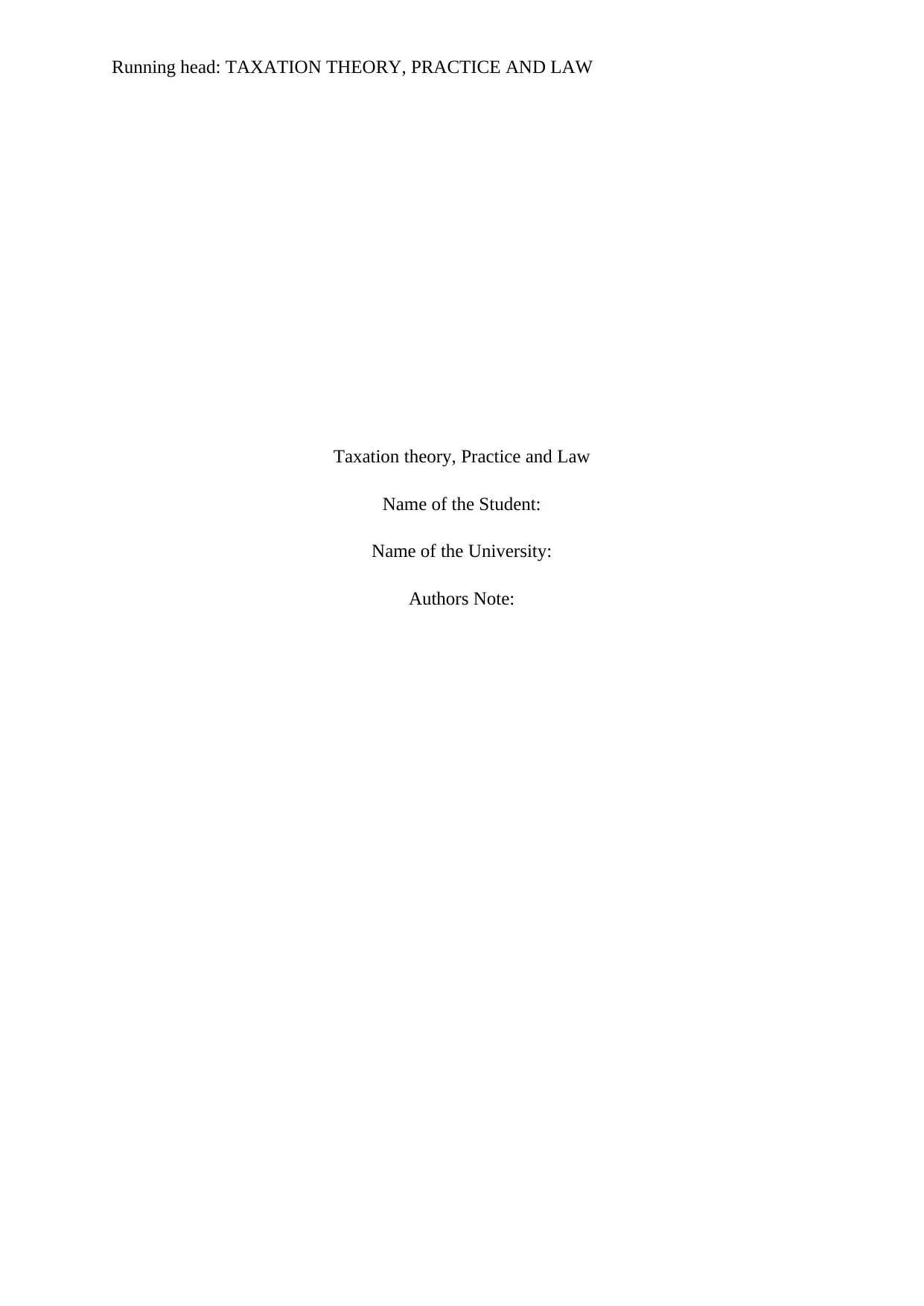
Running head: TAXATION THEORY, PRACTICE AND LAW
Taxation theory, Practice and Law
Name of the Student:
Name of the University:
Authors Note:
Taxation theory, Practice and Law
Name of the Student:
Name of the University:
Authors Note:
Paraphrase This Document
Need a fresh take? Get an instant paraphrase of this document with our AI Paraphraser
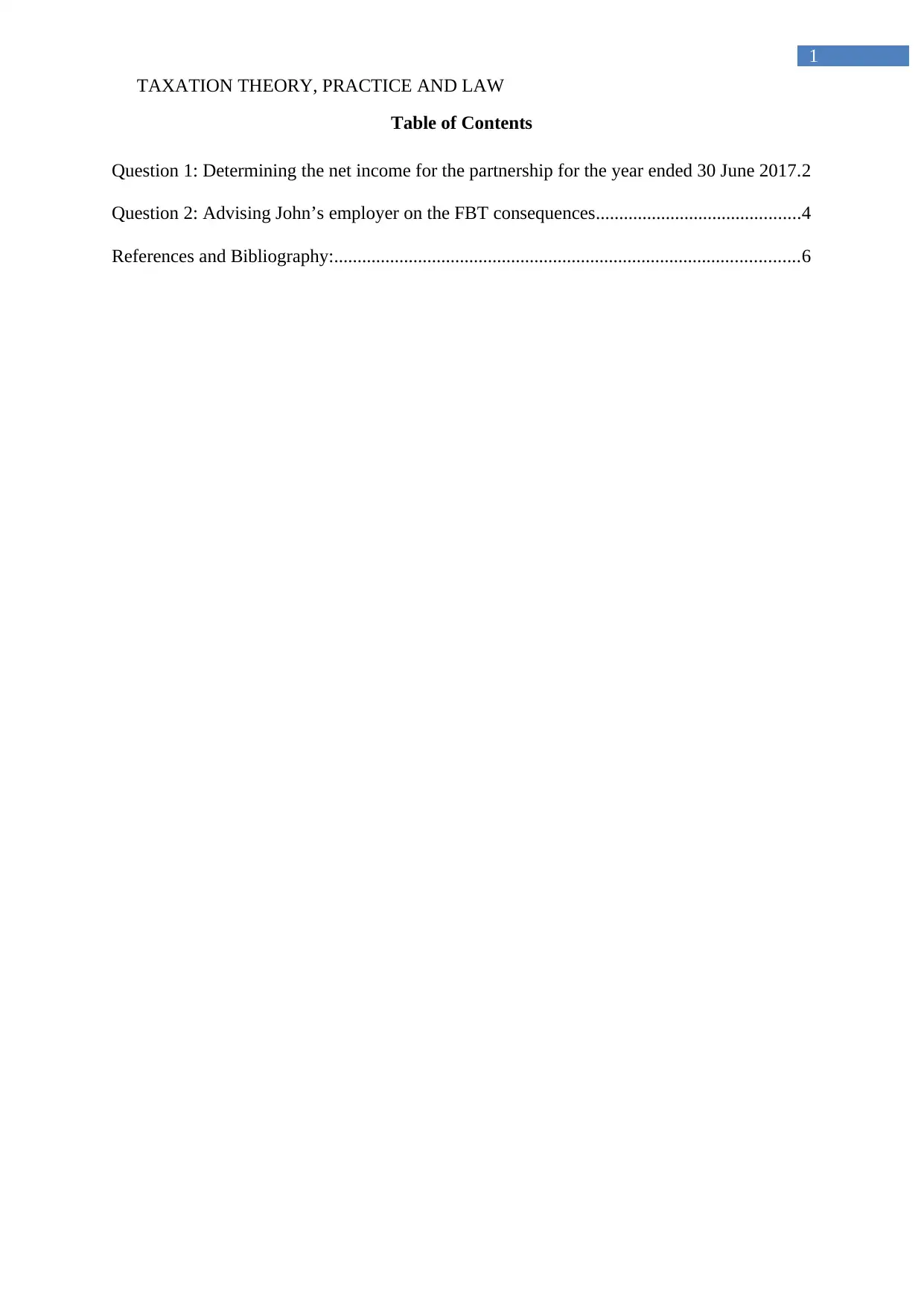
TAXATION THEORY, PRACTICE AND LAW
1
Table of Contents
Question 1: Determining the net income for the partnership for the year ended 30 June 2017.2
Question 2: Advising John’s employer on the FBT consequences............................................4
References and Bibliography:....................................................................................................6
1
Table of Contents
Question 1: Determining the net income for the partnership for the year ended 30 June 2017.2
Question 2: Advising John’s employer on the FBT consequences............................................4
References and Bibliography:....................................................................................................6
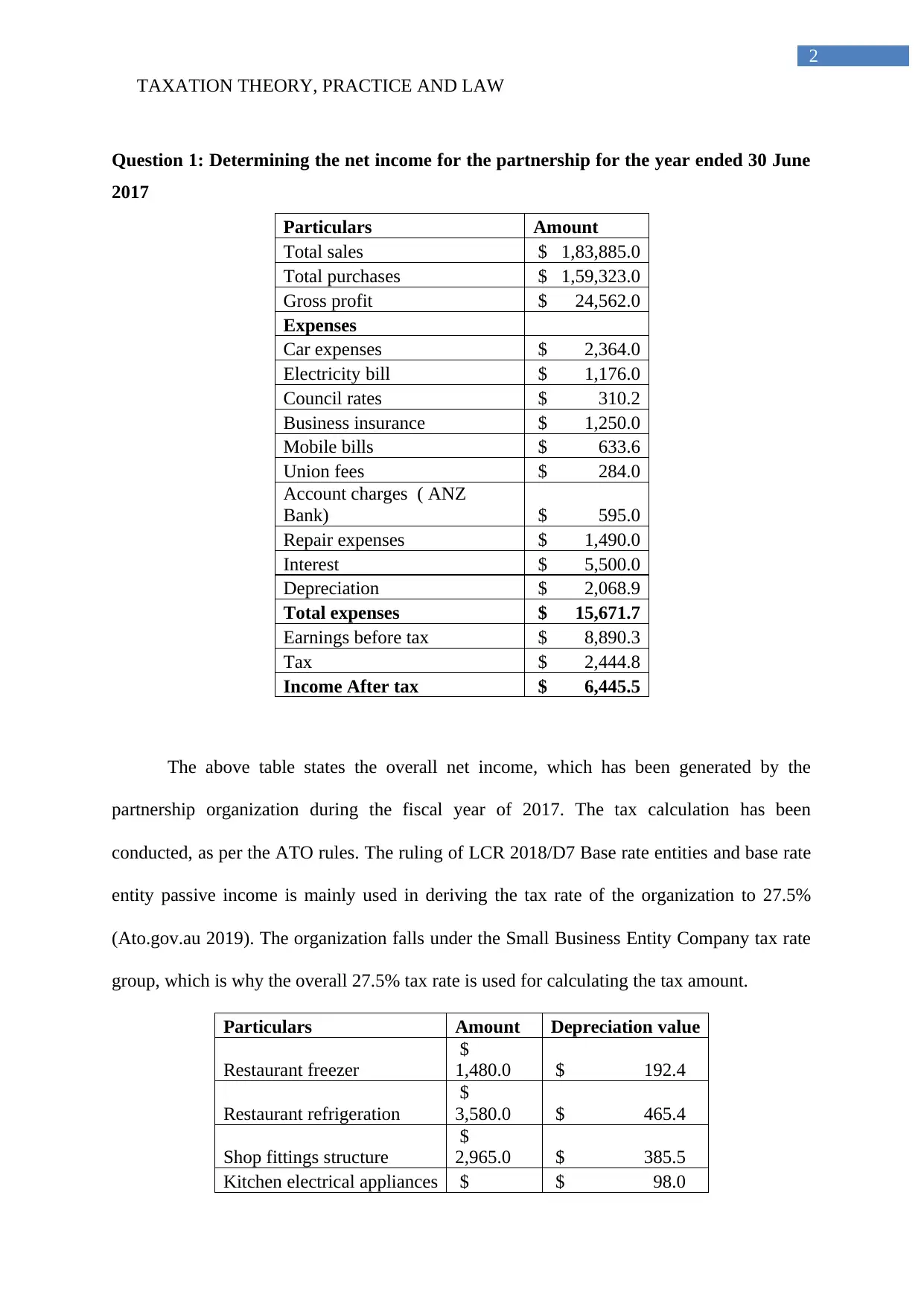
TAXATION THEORY, PRACTICE AND LAW
2
Question 1: Determining the net income for the partnership for the year ended 30 June
2017
Particulars Amount
Total sales $ 1,83,885.0
Total purchases $ 1,59,323.0
Gross profit $ 24,562.0
Expenses
Car expenses $ 2,364.0
Electricity bill $ 1,176.0
Council rates $ 310.2
Business insurance $ 1,250.0
Mobile bills $ 633.6
Union fees $ 284.0
Account charges ( ANZ
Bank) $ 595.0
Repair expenses $ 1,490.0
Interest $ 5,500.0
Depreciation $ 2,068.9
Total expenses $ 15,671.7
Earnings before tax $ 8,890.3
Tax $ 2,444.8
Income After tax $ 6,445.5
The above table states the overall net income, which has been generated by the
partnership organization during the fiscal year of 2017. The tax calculation has been
conducted, as per the ATO rules. The ruling of LCR 2018/D7 Base rate entities and base rate
entity passive income is mainly used in deriving the tax rate of the organization to 27.5%
(Ato.gov.au 2019). The organization falls under the Small Business Entity Company tax rate
group, which is why the overall 27.5% tax rate is used for calculating the tax amount.
Particulars Amount Depreciation value
Restaurant freezer
$
1,480.0 $ 192.4
Restaurant refrigeration
$
3,580.0 $ 465.4
Shop fittings structure
$
2,965.0 $ 385.5
Kitchen electrical appliances $ $ 98.0
2
Question 1: Determining the net income for the partnership for the year ended 30 June
2017
Particulars Amount
Total sales $ 1,83,885.0
Total purchases $ 1,59,323.0
Gross profit $ 24,562.0
Expenses
Car expenses $ 2,364.0
Electricity bill $ 1,176.0
Council rates $ 310.2
Business insurance $ 1,250.0
Mobile bills $ 633.6
Union fees $ 284.0
Account charges ( ANZ
Bank) $ 595.0
Repair expenses $ 1,490.0
Interest $ 5,500.0
Depreciation $ 2,068.9
Total expenses $ 15,671.7
Earnings before tax $ 8,890.3
Tax $ 2,444.8
Income After tax $ 6,445.5
The above table states the overall net income, which has been generated by the
partnership organization during the fiscal year of 2017. The tax calculation has been
conducted, as per the ATO rules. The ruling of LCR 2018/D7 Base rate entities and base rate
entity passive income is mainly used in deriving the tax rate of the organization to 27.5%
(Ato.gov.au 2019). The organization falls under the Small Business Entity Company tax rate
group, which is why the overall 27.5% tax rate is used for calculating the tax amount.
Particulars Amount Depreciation value
Restaurant freezer
$
1,480.0 $ 192.4
Restaurant refrigeration
$
3,580.0 $ 465.4
Shop fittings structure
$
2,965.0 $ 385.5
Kitchen electrical appliances $ $ 98.0
⊘ This is a preview!⊘
Do you want full access?
Subscribe today to unlock all pages.

Trusted by 1+ million students worldwide
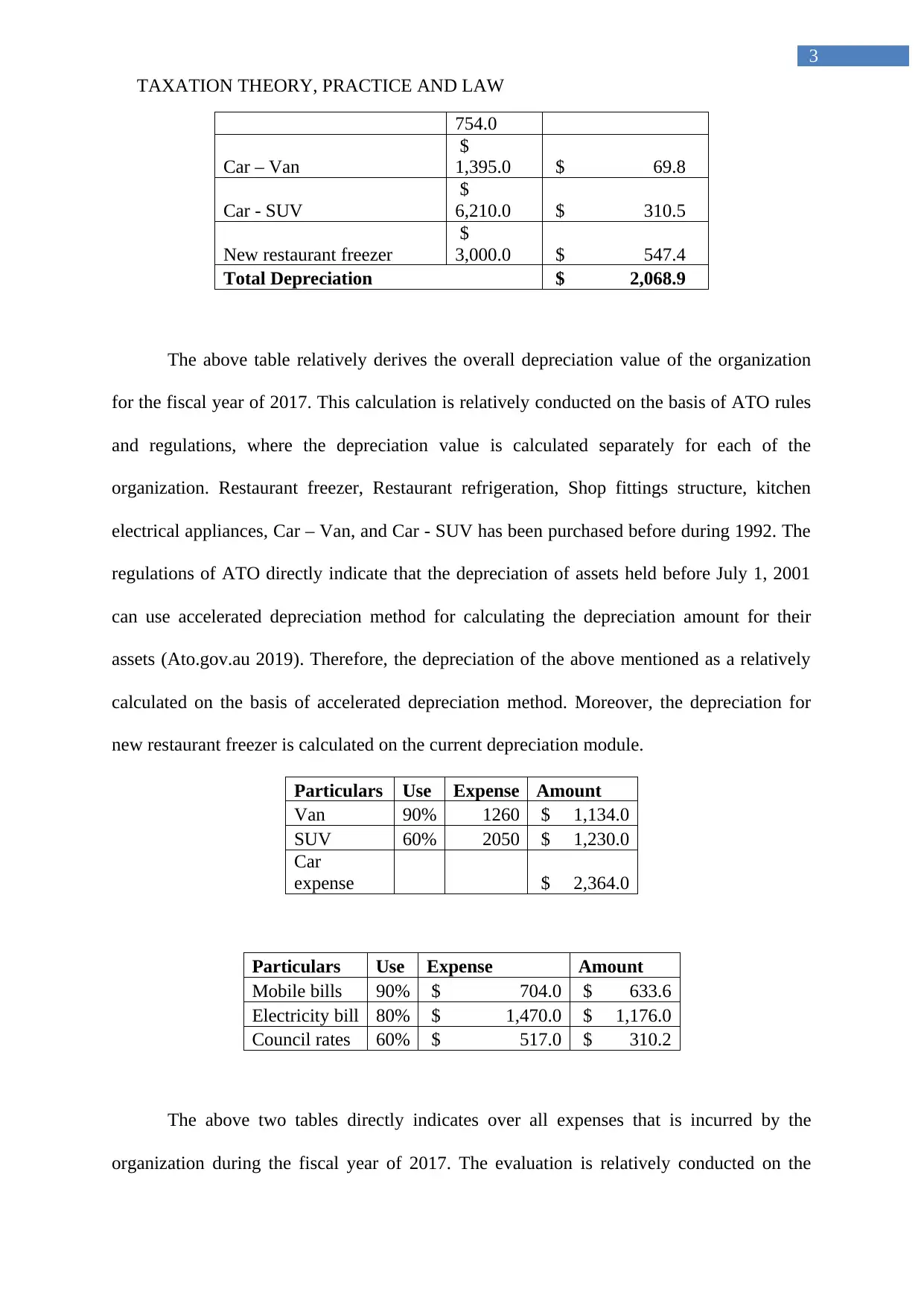
TAXATION THEORY, PRACTICE AND LAW
3
754.0
Car – Van
$
1,395.0 $ 69.8
Car - SUV
$
6,210.0 $ 310.5
New restaurant freezer
$
3,000.0 $ 547.4
Total Depreciation $ 2,068.9
The above table relatively derives the overall depreciation value of the organization
for the fiscal year of 2017. This calculation is relatively conducted on the basis of ATO rules
and regulations, where the depreciation value is calculated separately for each of the
organization. Restaurant freezer, Restaurant refrigeration, Shop fittings structure, kitchen
electrical appliances, Car – Van, and Car - SUV has been purchased before during 1992. The
regulations of ATO directly indicate that the depreciation of assets held before July 1, 2001
can use accelerated depreciation method for calculating the depreciation amount for their
assets (Ato.gov.au 2019). Therefore, the depreciation of the above mentioned as a relatively
calculated on the basis of accelerated depreciation method. Moreover, the depreciation for
new restaurant freezer is calculated on the current depreciation module.
Particulars Use Expense Amount
Van 90% 1260 $ 1,134.0
SUV 60% 2050 $ 1,230.0
Car
expense $ 2,364.0
Particulars Use Expense Amount
Mobile bills 90% $ 704.0 $ 633.6
Electricity bill 80% $ 1,470.0 $ 1,176.0
Council rates 60% $ 517.0 $ 310.2
The above two tables directly indicates over all expenses that is incurred by the
organization during the fiscal year of 2017. The evaluation is relatively conducted on the
3
754.0
Car – Van
$
1,395.0 $ 69.8
Car - SUV
$
6,210.0 $ 310.5
New restaurant freezer
$
3,000.0 $ 547.4
Total Depreciation $ 2,068.9
The above table relatively derives the overall depreciation value of the organization
for the fiscal year of 2017. This calculation is relatively conducted on the basis of ATO rules
and regulations, where the depreciation value is calculated separately for each of the
organization. Restaurant freezer, Restaurant refrigeration, Shop fittings structure, kitchen
electrical appliances, Car – Van, and Car - SUV has been purchased before during 1992. The
regulations of ATO directly indicate that the depreciation of assets held before July 1, 2001
can use accelerated depreciation method for calculating the depreciation amount for their
assets (Ato.gov.au 2019). Therefore, the depreciation of the above mentioned as a relatively
calculated on the basis of accelerated depreciation method. Moreover, the depreciation for
new restaurant freezer is calculated on the current depreciation module.
Particulars Use Expense Amount
Van 90% 1260 $ 1,134.0
SUV 60% 2050 $ 1,230.0
Car
expense $ 2,364.0
Particulars Use Expense Amount
Mobile bills 90% $ 704.0 $ 633.6
Electricity bill 80% $ 1,470.0 $ 1,176.0
Council rates 60% $ 517.0 $ 310.2
The above two tables directly indicates over all expenses that is incurred by the
organization during the fiscal year of 2017. The evaluation is relatively conducted on the
Paraphrase This Document
Need a fresh take? Get an instant paraphrase of this document with our AI Paraphraser
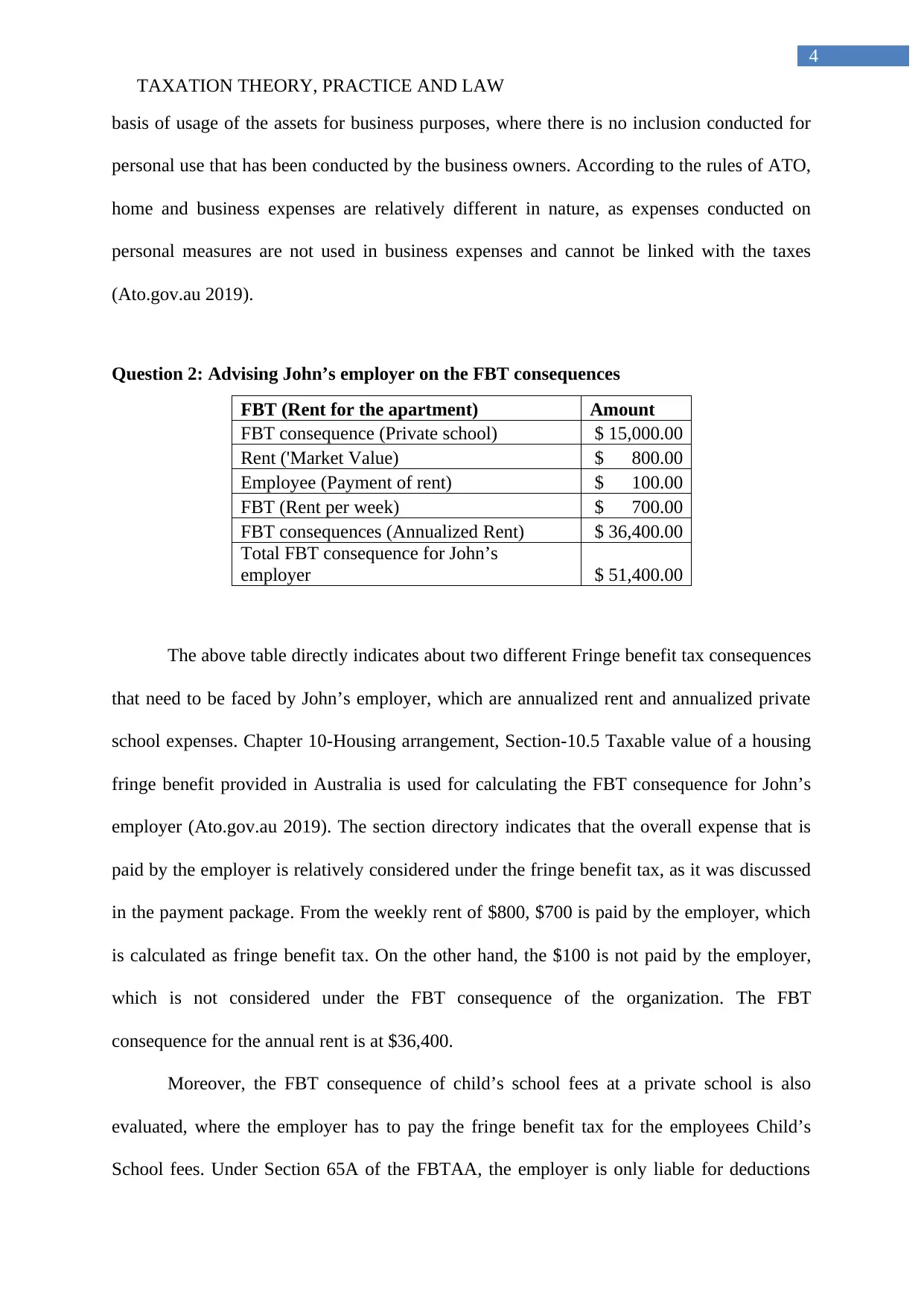
TAXATION THEORY, PRACTICE AND LAW
4
basis of usage of the assets for business purposes, where there is no inclusion conducted for
personal use that has been conducted by the business owners. According to the rules of ATO,
home and business expenses are relatively different in nature, as expenses conducted on
personal measures are not used in business expenses and cannot be linked with the taxes
(Ato.gov.au 2019).
Question 2: Advising John’s employer on the FBT consequences
FBT (Rent for the apartment) Amount
FBT consequence (Private school) $ 15,000.00
Rent ('Market Value) $ 800.00
Employee (Payment of rent) $ 100.00
FBT (Rent per week) $ 700.00
FBT consequences (Annualized Rent) $ 36,400.00
Total FBT consequence for John’s
employer $ 51,400.00
The above table directly indicates about two different Fringe benefit tax consequences
that need to be faced by John’s employer, which are annualized rent and annualized private
school expenses. Chapter 10-Housing arrangement, Section-10.5 Taxable value of a housing
fringe benefit provided in Australia is used for calculating the FBT consequence for John’s
employer (Ato.gov.au 2019). The section directory indicates that the overall expense that is
paid by the employer is relatively considered under the fringe benefit tax, as it was discussed
in the payment package. From the weekly rent of $800, $700 is paid by the employer, which
is calculated as fringe benefit tax. On the other hand, the $100 is not paid by the employer,
which is not considered under the FBT consequence of the organization. The FBT
consequence for the annual rent is at $36,400.
Moreover, the FBT consequence of child’s school fees at a private school is also
evaluated, where the employer has to pay the fringe benefit tax for the employees Child’s
School fees. Under Section 65A of the FBTAA, the employer is only liable for deductions
4
basis of usage of the assets for business purposes, where there is no inclusion conducted for
personal use that has been conducted by the business owners. According to the rules of ATO,
home and business expenses are relatively different in nature, as expenses conducted on
personal measures are not used in business expenses and cannot be linked with the taxes
(Ato.gov.au 2019).
Question 2: Advising John’s employer on the FBT consequences
FBT (Rent for the apartment) Amount
FBT consequence (Private school) $ 15,000.00
Rent ('Market Value) $ 800.00
Employee (Payment of rent) $ 100.00
FBT (Rent per week) $ 700.00
FBT consequences (Annualized Rent) $ 36,400.00
Total FBT consequence for John’s
employer $ 51,400.00
The above table directly indicates about two different Fringe benefit tax consequences
that need to be faced by John’s employer, which are annualized rent and annualized private
school expenses. Chapter 10-Housing arrangement, Section-10.5 Taxable value of a housing
fringe benefit provided in Australia is used for calculating the FBT consequence for John’s
employer (Ato.gov.au 2019). The section directory indicates that the overall expense that is
paid by the employer is relatively considered under the fringe benefit tax, as it was discussed
in the payment package. From the weekly rent of $800, $700 is paid by the employer, which
is calculated as fringe benefit tax. On the other hand, the $100 is not paid by the employer,
which is not considered under the FBT consequence of the organization. The FBT
consequence for the annual rent is at $36,400.
Moreover, the FBT consequence of child’s school fees at a private school is also
evaluated, where the employer has to pay the fringe benefit tax for the employees Child’s
School fees. Under Section 65A of the FBTAA, the employer is only liable for deductions
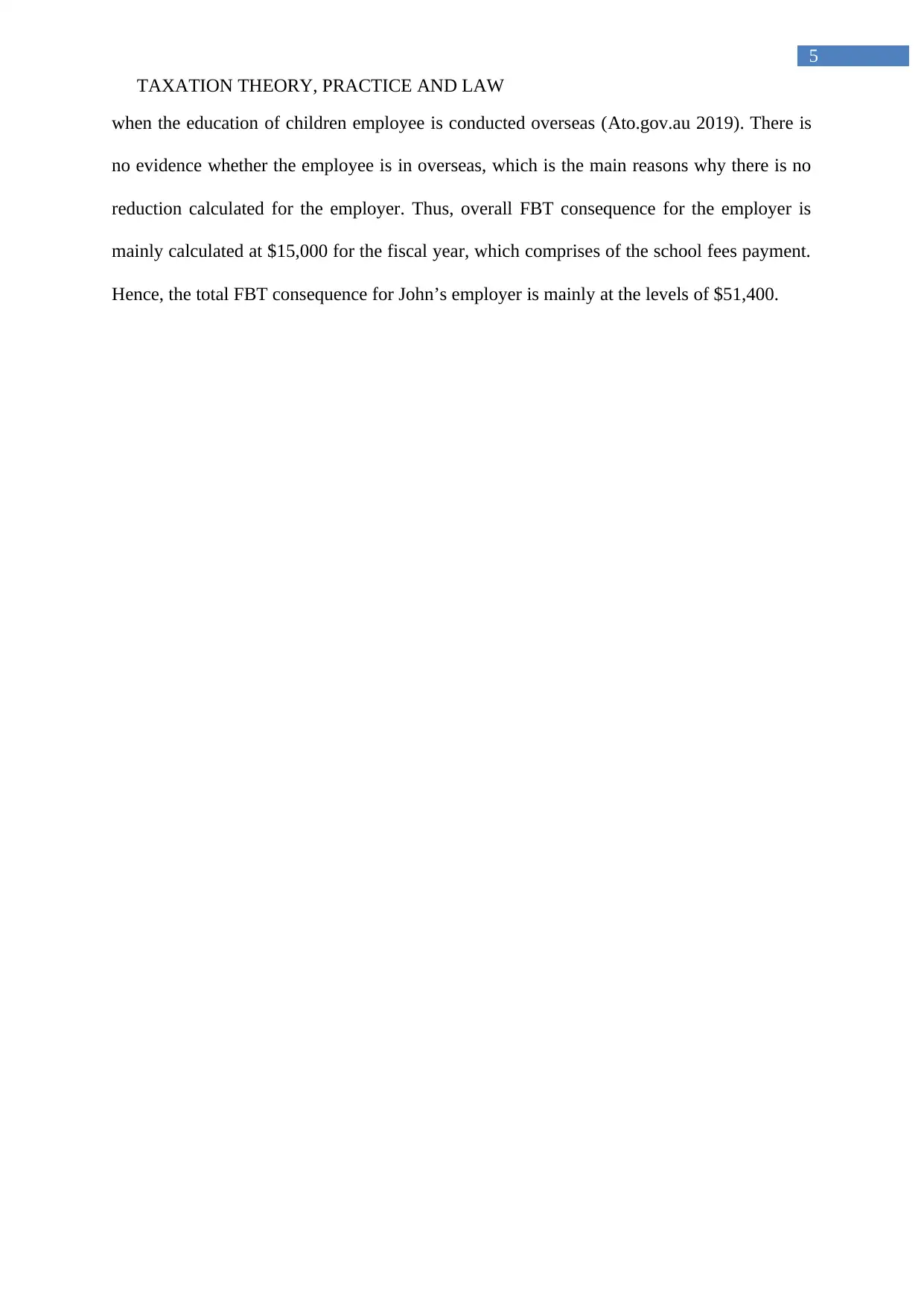
TAXATION THEORY, PRACTICE AND LAW
5
when the education of children employee is conducted overseas (Ato.gov.au 2019). There is
no evidence whether the employee is in overseas, which is the main reasons why there is no
reduction calculated for the employer. Thus, overall FBT consequence for the employer is
mainly calculated at $15,000 for the fiscal year, which comprises of the school fees payment.
Hence, the total FBT consequence for John’s employer is mainly at the levels of $51,400.
5
when the education of children employee is conducted overseas (Ato.gov.au 2019). There is
no evidence whether the employee is in overseas, which is the main reasons why there is no
reduction calculated for the employer. Thus, overall FBT consequence for the employer is
mainly calculated at $15,000 for the fiscal year, which comprises of the school fees payment.
Hence, the total FBT consequence for John’s employer is mainly at the levels of $51,400.
⊘ This is a preview!⊘
Do you want full access?
Subscribe today to unlock all pages.

Trusted by 1+ million students worldwide
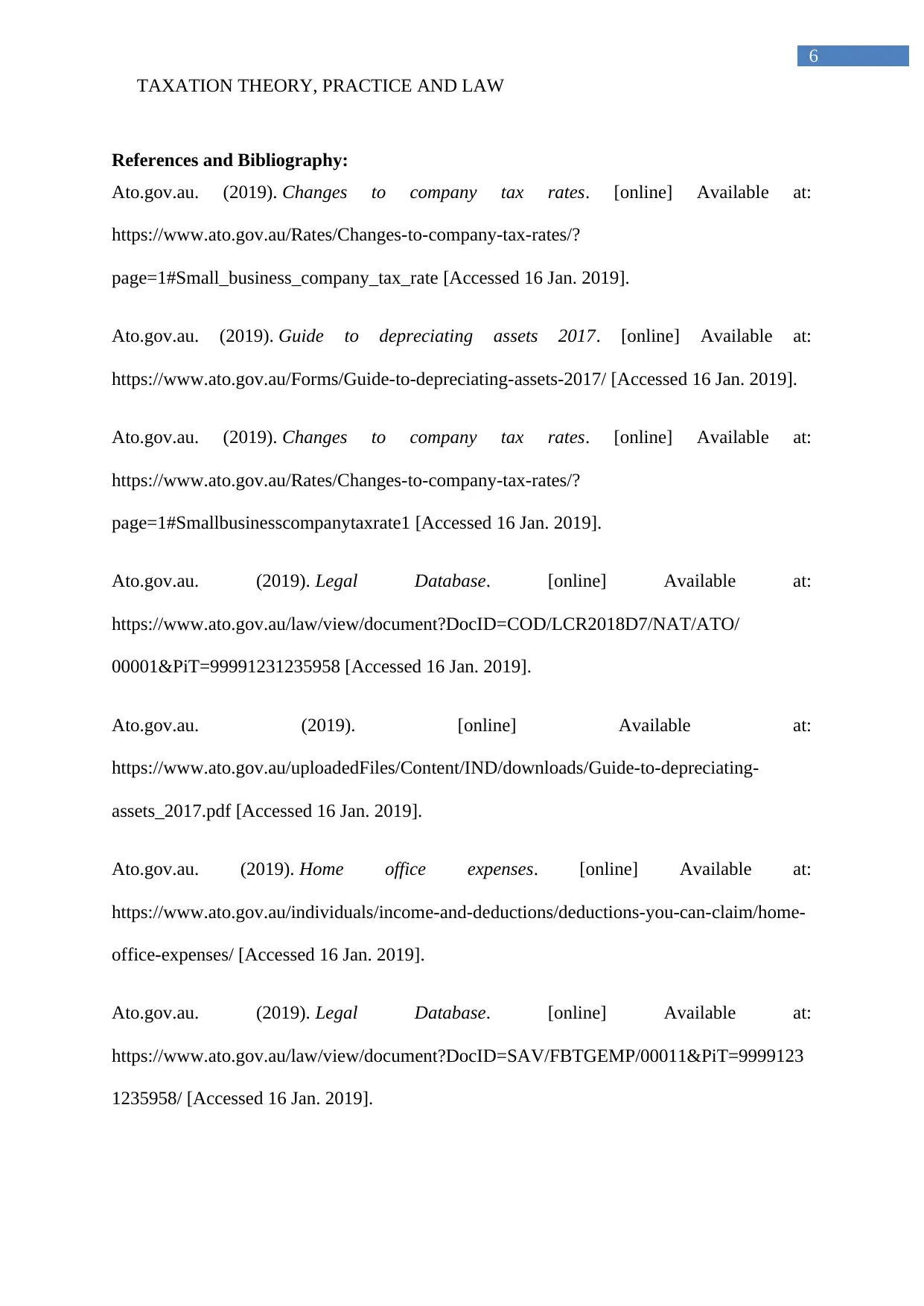
TAXATION THEORY, PRACTICE AND LAW
6
References and Bibliography:
Ato.gov.au. (2019). Changes to company tax rates. [online] Available at:
https://www.ato.gov.au/Rates/Changes-to-company-tax-rates/?
page=1#Small_business_company_tax_rate [Accessed 16 Jan. 2019].
Ato.gov.au. (2019). Guide to depreciating assets 2017. [online] Available at:
https://www.ato.gov.au/Forms/Guide-to-depreciating-assets-2017/ [Accessed 16 Jan. 2019].
Ato.gov.au. (2019). Changes to company tax rates. [online] Available at:
https://www.ato.gov.au/Rates/Changes-to-company-tax-rates/?
page=1#Smallbusinesscompanytaxrate1 [Accessed 16 Jan. 2019].
Ato.gov.au. (2019). Legal Database. [online] Available at:
https://www.ato.gov.au/law/view/document?DocID=COD/LCR2018D7/NAT/ATO/
00001&PiT=99991231235958 [Accessed 16 Jan. 2019].
Ato.gov.au. (2019). [online] Available at:
https://www.ato.gov.au/uploadedFiles/Content/IND/downloads/Guide-to-depreciating-
assets_2017.pdf [Accessed 16 Jan. 2019].
Ato.gov.au. (2019). Home office expenses. [online] Available at:
https://www.ato.gov.au/individuals/income-and-deductions/deductions-you-can-claim/home-
office-expenses/ [Accessed 16 Jan. 2019].
Ato.gov.au. (2019). Legal Database. [online] Available at:
https://www.ato.gov.au/law/view/document?DocID=SAV/FBTGEMP/00011&PiT=9999123
1235958/ [Accessed 16 Jan. 2019].
6
References and Bibliography:
Ato.gov.au. (2019). Changes to company tax rates. [online] Available at:
https://www.ato.gov.au/Rates/Changes-to-company-tax-rates/?
page=1#Small_business_company_tax_rate [Accessed 16 Jan. 2019].
Ato.gov.au. (2019). Guide to depreciating assets 2017. [online] Available at:
https://www.ato.gov.au/Forms/Guide-to-depreciating-assets-2017/ [Accessed 16 Jan. 2019].
Ato.gov.au. (2019). Changes to company tax rates. [online] Available at:
https://www.ato.gov.au/Rates/Changes-to-company-tax-rates/?
page=1#Smallbusinesscompanytaxrate1 [Accessed 16 Jan. 2019].
Ato.gov.au. (2019). Legal Database. [online] Available at:
https://www.ato.gov.au/law/view/document?DocID=COD/LCR2018D7/NAT/ATO/
00001&PiT=99991231235958 [Accessed 16 Jan. 2019].
Ato.gov.au. (2019). [online] Available at:
https://www.ato.gov.au/uploadedFiles/Content/IND/downloads/Guide-to-depreciating-
assets_2017.pdf [Accessed 16 Jan. 2019].
Ato.gov.au. (2019). Home office expenses. [online] Available at:
https://www.ato.gov.au/individuals/income-and-deductions/deductions-you-can-claim/home-
office-expenses/ [Accessed 16 Jan. 2019].
Ato.gov.au. (2019). Legal Database. [online] Available at:
https://www.ato.gov.au/law/view/document?DocID=SAV/FBTGEMP/00011&PiT=9999123
1235958/ [Accessed 16 Jan. 2019].
Paraphrase This Document
Need a fresh take? Get an instant paraphrase of this document with our AI Paraphraser
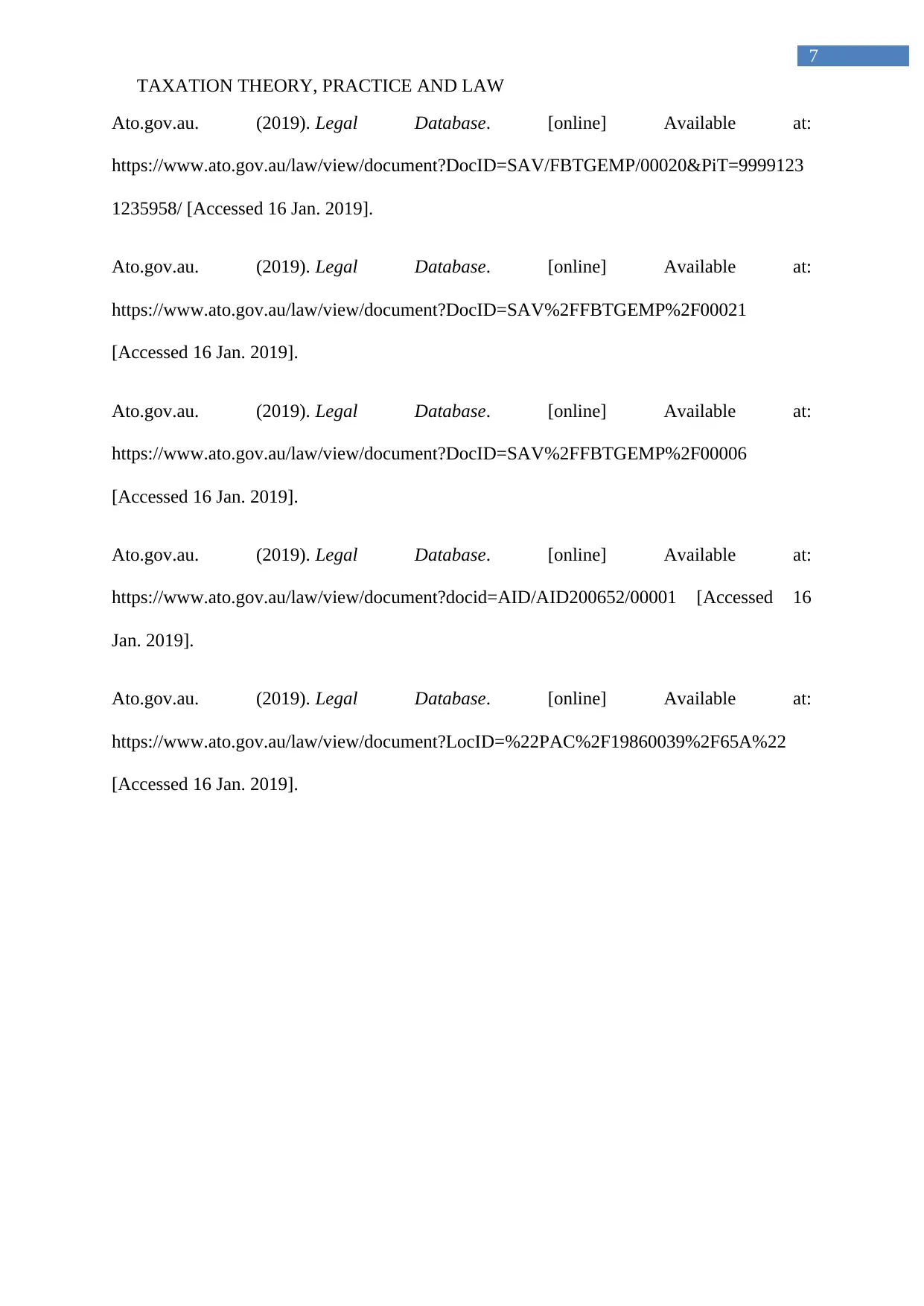
TAXATION THEORY, PRACTICE AND LAW
7
Ato.gov.au. (2019). Legal Database. [online] Available at:
https://www.ato.gov.au/law/view/document?DocID=SAV/FBTGEMP/00020&PiT=9999123
1235958/ [Accessed 16 Jan. 2019].
Ato.gov.au. (2019). Legal Database. [online] Available at:
https://www.ato.gov.au/law/view/document?DocID=SAV%2FFBTGEMP%2F00021
[Accessed 16 Jan. 2019].
Ato.gov.au. (2019). Legal Database. [online] Available at:
https://www.ato.gov.au/law/view/document?DocID=SAV%2FFBTGEMP%2F00006
[Accessed 16 Jan. 2019].
Ato.gov.au. (2019). Legal Database. [online] Available at:
https://www.ato.gov.au/law/view/document?docid=AID/AID200652/00001 [Accessed 16
Jan. 2019].
Ato.gov.au. (2019). Legal Database. [online] Available at:
https://www.ato.gov.au/law/view/document?LocID=%22PAC%2F19860039%2F65A%22
[Accessed 16 Jan. 2019].
7
Ato.gov.au. (2019). Legal Database. [online] Available at:
https://www.ato.gov.au/law/view/document?DocID=SAV/FBTGEMP/00020&PiT=9999123
1235958/ [Accessed 16 Jan. 2019].
Ato.gov.au. (2019). Legal Database. [online] Available at:
https://www.ato.gov.au/law/view/document?DocID=SAV%2FFBTGEMP%2F00021
[Accessed 16 Jan. 2019].
Ato.gov.au. (2019). Legal Database. [online] Available at:
https://www.ato.gov.au/law/view/document?DocID=SAV%2FFBTGEMP%2F00006
[Accessed 16 Jan. 2019].
Ato.gov.au. (2019). Legal Database. [online] Available at:
https://www.ato.gov.au/law/view/document?docid=AID/AID200652/00001 [Accessed 16
Jan. 2019].
Ato.gov.au. (2019). Legal Database. [online] Available at:
https://www.ato.gov.au/law/view/document?LocID=%22PAC%2F19860039%2F65A%22
[Accessed 16 Jan. 2019].
1 out of 8
Related Documents
Your All-in-One AI-Powered Toolkit for Academic Success.
+13062052269
info@desklib.com
Available 24*7 on WhatsApp / Email
![[object Object]](/_next/static/media/star-bottom.7253800d.svg)
Unlock your academic potential
Copyright © 2020–2025 A2Z Services. All Rights Reserved. Developed and managed by ZUCOL.





